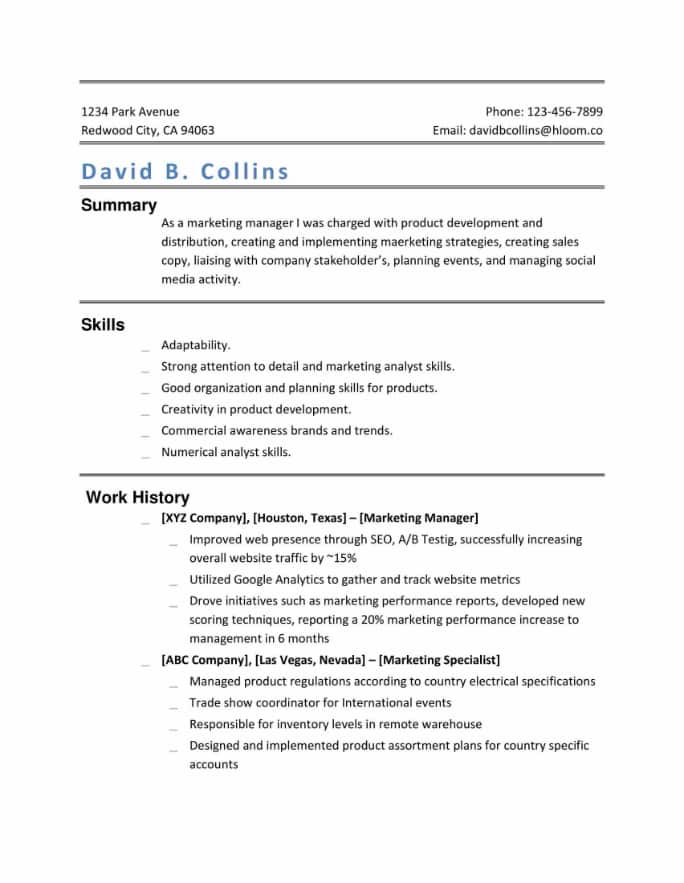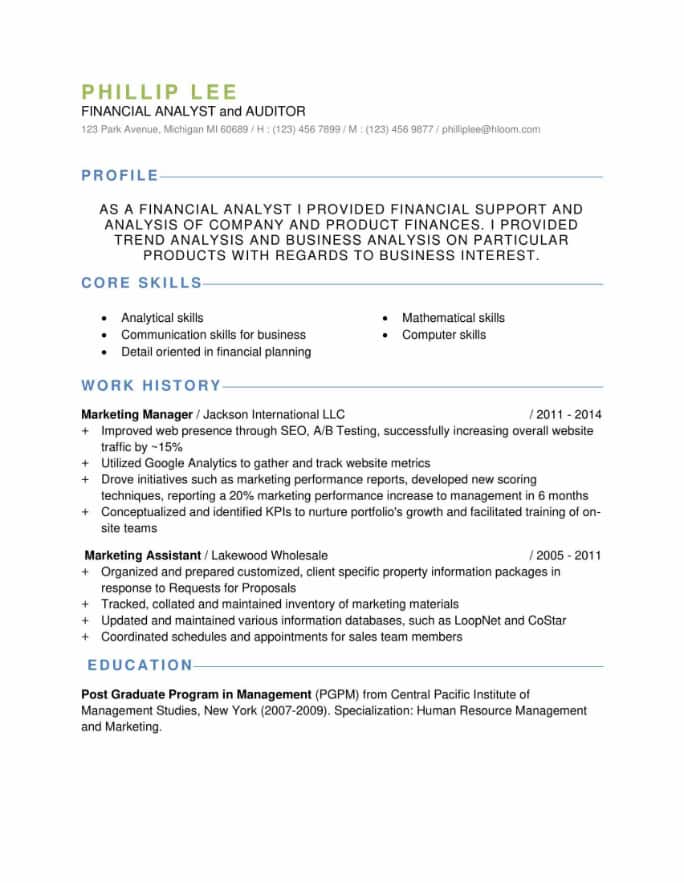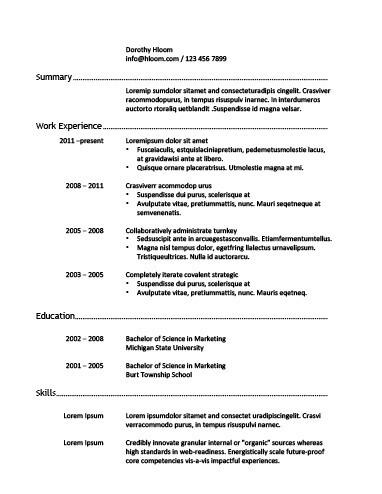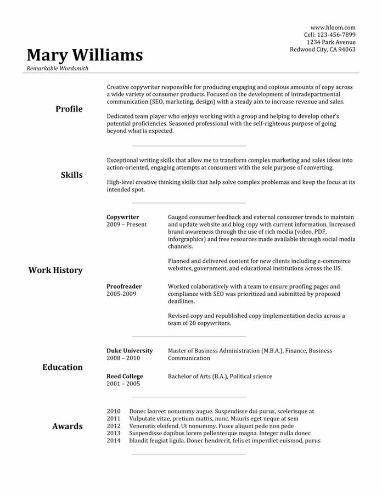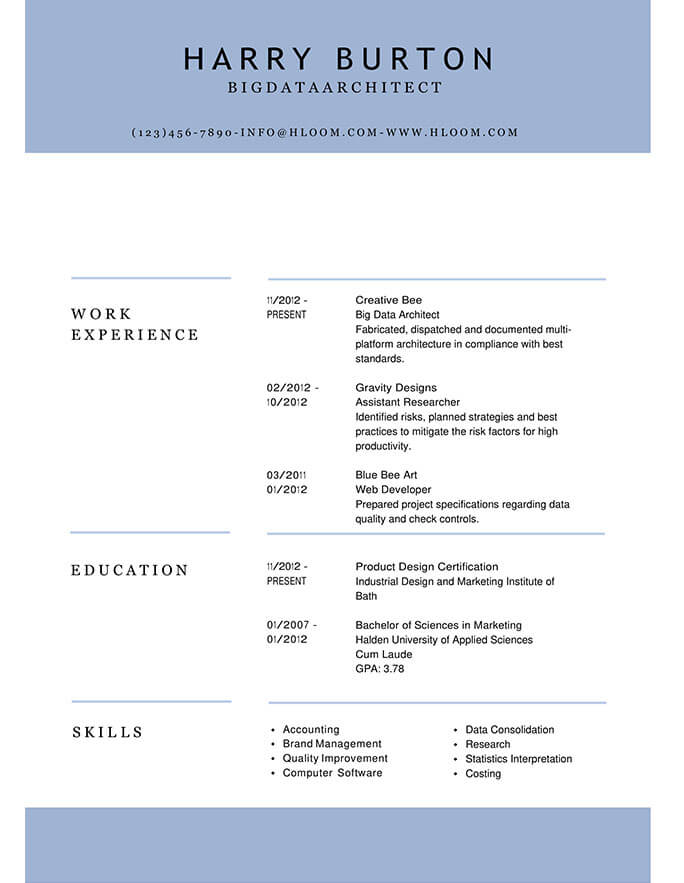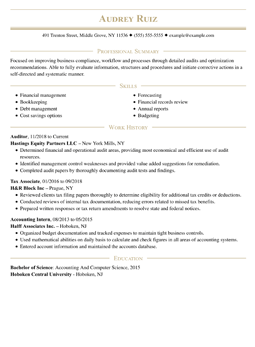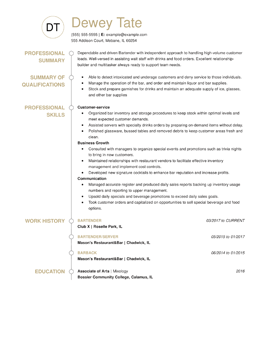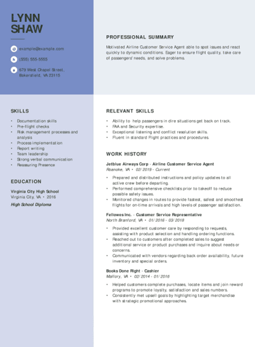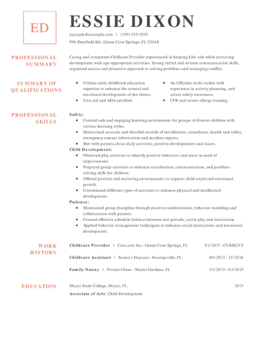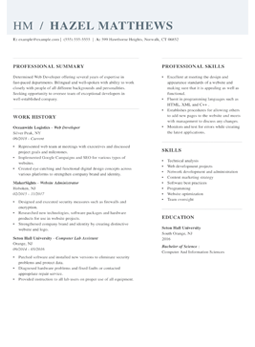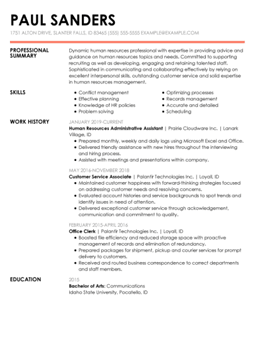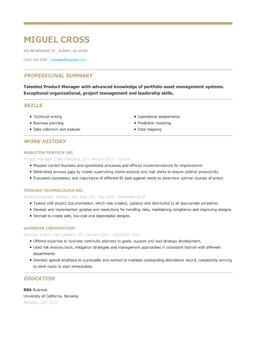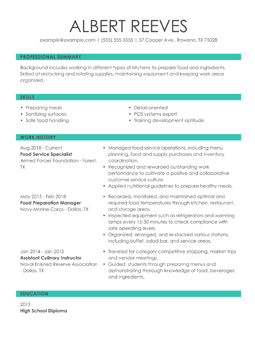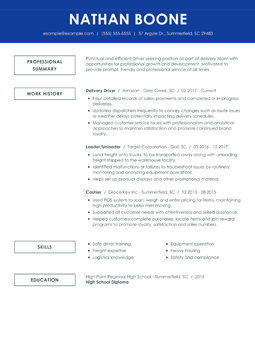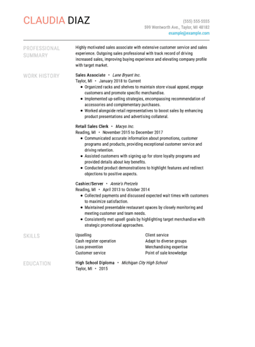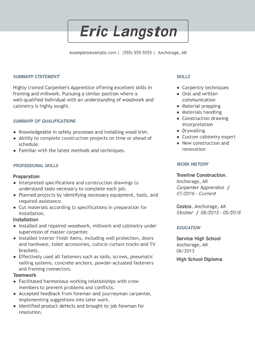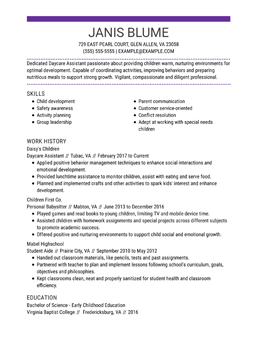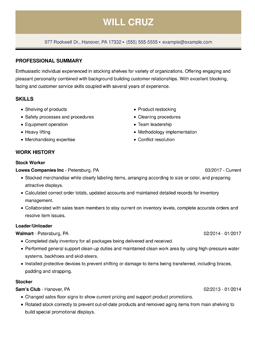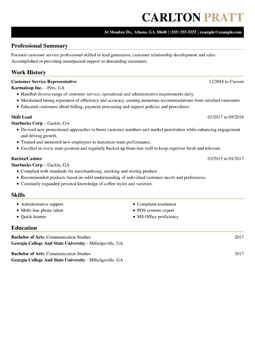Free Downloadable Food Service Resume Templates and Expert Writing Tips

- Featured In:

Table of Contents
Here are more resources that can help you
-
Resume/CV Templates
-
- Basic Resume Template
- Creative Resume Template
- Portfolio Resume Template
- Modern Resume Template
- ATS Resume Template
- One-Page Resume Template
- Google Docs Resume Template
- CV Template
- Biodata Resume Template
- Writer Resume Example
- High School Student Resume Example
- Internship Resume Example
- Entry Level Resume Example
- Massage Therapist Resume Example
- Medical Assistant Resume Example
- Cashier Resume Example
- BabySitter Resume Example
- Customer Service Example
- Attorney Resume Example
- Customer Service Representative Resume Example
- Teacher Resume Example
- Engineering Resume Example
- Nurse Resume Example
- Latex Resume Template
- College Student Resume Example
- High School Graduate Resume Example
-
Resume Help
Statistics show that in 2020 the food service profession supplied approximately $813.4 billion worth of food –– all of it handled by talented job seekers like you. Whether you’re a waiter, bartender or restaurant manager, we’ll give you the best resume writing advice to help you stand out in this competitive industry. Our resume examples and downloadable templates made by professionals will help you highlight your skills and find your next job in the food service industry.
Best Free Downloadable Resume Templates for Food Service Jobs
-
Non Traditional
This resume template offers a no-fuss design that focuses first on the skills section and then the work history, making it ideal for midlevel candidates who have transferable skills and a few years of experience. -
New Agenda
This template's simple design and single-column layout prioritizes the skills section, which you can fill with relevant food service skills such as menu planning, inventory management and food sanitation. -
Front Center
With a distinctly contemporary design and the option to add a profile picture, this template can work well for bartenders, hosts or lead waiters, especially those with an extensive work history, which is the main section of this template. -
Hard Worker
A clean and straightforward option for any food service professional, this template opens with the classic professional summary where you should list your top qualifications relevant to the desired role. -
Goldfish Bowl
This black and white, traditional resume template gives an air of authority, making it a great choice for food service managerial positions. Tailor your skills to the desired role and don't forget to include quantifiable accomplishments in your work history for maximum impact. -
Hire
This resume template has a visually engaging design with a red pop of color and linear design elements. Candidates with a strong professional background will benefit from this resume that places importance on the work history section.
9 Food Service Resume Examples
Resumes come in three distinct formats: functional, combination and chronological formats. Each format serves a different purpose and can be utilized based on your experience level and skills. Resume formats strategically showcase your top strengths and downplay your limitations. Therefore, selecting the appropriate format can mean the difference between getting rejected or considered for a job.
We’ve created resume formats for hypothetical candidates in the food service industry so you can appreciate how different they look depending on the format. Let’s browse them and figure out the perfect resume format for you.
Chronological Resume
The chronological format is ideal for professionals with over a decade of experience in the food service industry. We suggest incorporating this layout for the following food service roles:
Food and beverage managers, restaurant managers, lead mixologists and bar managers all generally have at least 10 years of experience under their belt. Professionals can boast their industry expertise and back it up with a diverse skill set. A food service resume in the chronological layout can look something like this:
-
1. Bartenders: This professional resume perfectly showcases the candidate’s journey from being a barback to a lead mixologist through reverse chronology. It also highlights the versatile skills such as spirits knowledge, mixology and inventory management picked up by the candidate through years of experience. Planning menus and training new employees also add to their leadership skills.
-
2. Food and Beverage Managers: Food service managers have to overlook staff scheduling, food and safety hygiene standards, and coach and motivate their employees. This applicant's resume goes into detail by shedding light on all their responsibilities and quantifying them with numeric data. The chronological format shows the candidate's steady job flow in the same industry. For a manager, skills like trend analysis and facility management are a great addition.
-
3. Restaurant Servers: Highly-traJenna’s resume may lack a specialized degree or certification but the work experience shows her credibility and skills. Food safety knowledge and memorization are a must for servers. Expert tip: Quantify key skills in your work history section. For example, this resume highlights Jenna’s ability to serve around 300 guests in a shift.
Combination Resume
The combination format is for you if you have the skills and hands-on training but have limited industry experience. This resume format gives equal importance to a candidate’s skills and work history, and shows off a strong candidate all around. Because of its balanced focus on qualifications, the combination format is also a great choice if you want to apply for a promotion.
Combination resumes can be lengthier and include the skills section before or alongside the work history. We suggest utilizing this format if you’re pursuing the following food service profiles.
-
1. Barbacks: Barbacks usually assist the lead bartenders in ensuring smooth service. Notice how this applicant's resume puts the skills section alongside the work history; this ensures the recruiter looks at the skills section right after the professional summary. By highlighting mixology training and POS knowledge, the combination format adds importance to the candidate’s skills.
-
2. Busser: The combination format is especially helpful for keeping the focus on your specialized skills. Although this candidate started out as a customer service associate, he eventually moved to the food service industry.He'll want to use the professional summary and skills to mention relevant skills like customer satisfaction and attention to detail. Instead of shedding light on the limited industry experience, focus on the versatile skills gained through various jobs.
-
3. Restaurant Servers: Servers with minimal experience can amp up their resumes through the combination format's dual focus on skills and work history. This resume example includes an additional summary to highlight key skills for a food service professional. By quantifying the accomplishments in the work history, you can also show you've had a measurable impact on the job.
Functional Resume
Functional formats focus mainly on a candidate’s skills section, making this resume ideal for candidates with little to no formal experience. If utilized correctly, functional formats can benefit people who’ve recently graduated school or have long career gaps.
If you’re applying for leadership roles that require evidence of formal experience, we suggest looking at other resume formats. However, if your profile is more skill-based, you can opt for a functional format to easily convince employers you have everything you need to excel at the job.
-
1. Baristas: Baristas need to be skilled at brewing coffees, creating beverage recipes and maintaining station hygiene. Functional resumes are the perfect fit for entry-level candidates who have less than two years of experience. This resume example gets the job done by emphasizing the candidate's professional skills first and simply outlining the job history at the end.
-
2. Entry-level Bartenders: This candidate's resume plays up bartending skills like mixology, supply management and bar operations. The summary of qualifications gives her a chance to briefly elaborate and quantify her skills, while the main skills section goes into depth by mentioning various accomplishments per skill.
-
3. Catering Servers: The key with functional resumes is to highlight a candidate’s skills and downplay their inexperience. This applicant's resume has three different skills sections: one summary, one list and the expanded skills section so employers get a comprehensive idea of all their qualifications despite having a minimal work history section.
What Can You Earn as a Food Service Professional?
If you’re planning to join the food service industry, you’ll want to know what you can earn in various roles. Your wages will depend on your specific role, employer and work location. To get started, you can check out the Bureau of Labor Statistics‘ May 2024 findings for the median hourly wages for food service jobs.
Top Food Service Skills for Your Resume
Your resume’s skills section is crucial for the employer to assess if you’re the right person for the job. The skills section becomes even more important for positions that don’t require formal education, such as Barista or Busser. Having a diverse set of skills can give you an advantage even if you don’t have much experience or formal education.
You can include a varied selection of soft, hard and technical skills throughout your resume in the following sections:
- Professional Summary: The summary statement can include one to two skills relevant to the job right at the start of your resume since most HR professionals will scan this section before browsing through your work history. For example, a waitress could start out by highlighting her ability to work in a fast-paced environment and her knowledge of food safety.
- Skills Section: This section should primarily focus on listing out relevant skills that the employer is looking for. Add six to eight food service skills, ideally a mix of soft, hard and technical skills. For example, almost every food service professional should have physical stamina, sanitization training and menu and product knowledge.
- Work History: Try showcasing at least one skill when describing your accomplishments in each job and always try to quantify them. For example, a bartender can mention making on-menu cocktails to 200+ customers in a certain period of time. Instead of providing a vague recollection of generic tasks, add numeric value for credibility.
We’ve gathered a list of food service skills in each skill type that you can reference when building out your various resume sections. Learn what each skill type consists of and check out their respective examples below.
Soft skills
Soft skills are personality traits tied to your personality that enable you to keep up with your work environment and perform your work as efficiently as possible. They might seem unrelated to your job but are crucial for career growth. Some soft skills that you’ll require as a food service professional are:
- 1. Attention to detail
- 2. Patience with customers
- 3. Verbal communication
- 4. Active listening
- 5. Multitasking
- 6. Physical stamina
- 7. Collaboration
- 8. Conflict resolution and de-escalation
- 9. Mathematical skills
Hard skills
Hard skills are traits you gain through experience or education, they vary depending on the industry or role. With the proper training, you can enhance your hard skills over time. Here are a few hard skills related to the food service industry:
- 1. Food safety knowledge
- 2. Meal prep
- 3. Inventory management
- 4. Supervision of bar
- 5. Staff training
- 6. Floor staff management
- 7. Bussing tables
- 8. Sanitization
- 9. Overlooking compliance of bar rules
- 10. Operating tray line
- 11. Vendor relations
- 12. Menu Planning
Technical skills
Technical skills refer to your ability to handle the tools and technologies of your role or industry. They can be slightly generic, like proficiency with MS Office tools or more specific to the job, like knowledge of point of sale (POS) systems. Some examples of food service technical skills are:
- 1. Operating stove and frying equipment
- 2. Cash register handling
- 3. Proficiency in various POS systems
- 4. Practical knowledge of restaurant management software, i.e., Toast, OpenTable, 7 Shifts
- 5. Adept with accounting and billing software, i.e., Restaurant365, QuickBooks
Best 5 Certifications for Your Food Service Resume
Many roles in the food service industry generally don’t require a bachelor’s or master’s degree, except in some cases for senior or management positions. However, a food safety or alcohol service license might be essential for your desired role. In fact, acquiring and adding specialized certifications to your resume can be a game-changer when it comes down between two candidates. Here are some certifications that can aid you in landing a food service job:
- OSHA Safety Certificate
- Certified Food Manager (CFM)
- Certified Food Protection Professional (CFPP)
- Certified Professional — Food Safety (CP-FS)
- Food Safety Manager Certification
- Mixology Course
- Barista Guild Certification
Improve Your Writing Speed with a Resume Builder
Our dynamic Resume Builder can help you craft an effective resume in three simple steps. Start with finding the perfect premade template, by answering some questions about your years of experience and desired role. Next, select the template, check our industry-specific suggestions for all your sections, customize it with your quantifiable achievements and run it through our spell check. Then, save and download or print your resume. You can even store unlimited resumes or CVs on your online profile when you use Hloom's resume builder.
This simple layout features a traditional font and the clever use of section borders to help each section of your resume stand out.
This distinctive two-column resume template identifies your name and professional experience in a bold color and clean presentation.
A clever design that breaks each of your professional accomplishments into distinct sections while following a format that will pass applicant tracking systems.
The elegant initials, simple header and strategic use of bullet points in this template help keep your professional accomplishments well-organized.
The bold use of a colorblocked heading paired with an elegant resume layout helps your name and contact information stand out.
This structured design combines a two-column approach with bullet points to highlight your key accomplishments and professional history.
A traditional template uses a crisp combination of dark text and thin borders to radiate professionalism. Your name sits prominently above your professional history.
This template’s design features plenty of whitespace neatly divided by gray bars to make the information on your resume easy to read for employers.
This two-column resume conveys a very clear breakdown of its sections that allows a hiring manager to quickly scan your resume.
The subtle color accents in this template add visual pizzazz in a classy way, a great option for most traditional industries.
This resume’s modern design and bold use of color make it pop. Its uniqueness is well-suited to those seeking jobs in creative industries.
Everything about this template is assertive from the boxy layout to its all-caps heading text that gives the impression that you’re all about business.
The understated contact information at the top puts attention front and center on your professional summary, skills, work experience and education sections.
The subtle use of red alongside black gives this template a bold feel while still featuring plenty of white space to make it easy to read.
Customer Reviews
FAQ
Do I require any special training to join the food service industry?
Most hiring places expect at least a high school diploma or GED. However, a Bachelor’s in Food Service Management, Culinary Arts or Hospitality Management can prove to be beneficial for a myriad roles. You can even acquire additional certificates such as a Food Handler’s Card or a Food Safety Certification. Bartenders and baristas can opt for specialized beverage-making training courses which can set you apart from the applicant pool.
What is a food handler’s license and why is it important?
A food handler’s card or license certifies a person for the completion of a food safety program. These permits are state or government-approved. Food service novices can find online courses to learn about food allergies, contamination, temperature control and hygiene. This type of certification is especially valuable if you visualize yourself heading into management positions in the industry.
What are some tasks that I’ll carry out as a food service professional?
The tasks you perform as a food service professional can vary depending on your exact role. However, a few general examples of tasks you might have to complete in any restaurant, pub or cafe are:
- A food service manager has to take stock of the inventory, schedule staff shifts, supervise the food prep and ensure employees follow food hygiene and safety protocols.
- A bartender must serve drinks and offer recommendations, adhere to liquor laws, create signature beverages and manage inventory.
- A busser is expected to prep and decorate the dining area, serve food, reset tables and maintain hygiene in the dining area.
Rate our Templates
